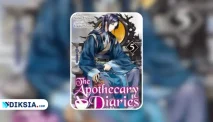A Classic Novel That Explores The Power Dynamics And Human Drama of a Mental Ward
Diksia.com - One Flew Over the Cuckoo’s Nest is a novel by Ken Kesey that was published in 1962. It is widely regarded as one of the greatest American novels of the 20th century, and has been adapted into a film, a play, and an opera. The novel tells the story of Randle Patrick McMurphy, a rebellious and charismatic convict who is transferred to a mental hospital after faking insanity to avoid hard labor.
There, he clashes with Nurse Ratched, a tyrannical and manipulative woman who rules the ward with an iron fist. McMurphy becomes the leader of a group of patients who are oppressed and dehumanized by the hospital system, and tries to inspire them to rebel and regain their dignity and freedom.
The novel is narrated by Chief Bromden, a half-Native American patient who pretends to be deaf and mute to avoid attention. He is a paranoid schizophrenic who believes that the hospital is controlled by a sinister machine called the Combine, which aims to destroy individuality and conform everyone to its will. Through his eyes, we witness the events that unfold in the ward, as well as his own memories and hallucinations.
One Flew Over the Cuckoo’s Nest is a book that combines humor and tragedy, realism and fantasy, satire and allegory. It is a powerful critique of the psychiatric system and its abuses, as well as a commentary on the social and political issues of the 1960s, such as racism, sexism, authoritarianism, and conformity. It is also a moving exploration of the themes of sanity and madness, freedom and oppression, courage and cowardice, friendship and betrayal, life and death.
Book Details
– Title: One Flew Over the Cuckoo’s Nest
– Author: Ken Kesey
– Genres: Fiction, Literary Fiction
– Chapter: 4 parts, 28 chapters
– Language: English
– Publisher: Viking Press
– Publication date: February 1, 1962
– Rating: 4.2 out of 5 stars on Goodreads
– Awards: Oregon Book Award for Fiction (1987)
Recommended Audience
One Flew Over the Cuckoo’s Nest is a book that is suitable for older teens and adults who are interested in reading a classic novel that challenges the reader’s perception of reality and society. The book contains mature content such as profanity, violence, sexual references, drug use, and disturbing scenes that may not be appropriate for younger or sensitive readers.
The book also deals with controversial topics such as mental illness, suicide, electroshock therapy, lobotomy, racism, sexism, and homosexuality that may require some background knowledge and critical thinking to understand and appreciate.
Overview
One Flew Over the Cuckoo’s Nest is a novel that follows the exploits of Randle Patrick McMurphy, a rebellious convict who is transferred to a mental hospital after faking insanity to avoid hard labor. He soon realizes that he has made a mistake, as he finds himself in a ward ruled by Nurse Ratched, a cold-hearted woman who uses her authority to manipulate and control her patients.
McMurphy becomes the leader of a group of patients who are oppressed and dehumanized by the hospital system, and tries to challenge Nurse Ratched’s power by organizing various acts of defiance and resistance. He also befriends Chief Bromden, a half-Native American patient who pretends to be deaf and mute to avoid attention. Chief Bromden is the narrator of the novel, who reveals his own perspective on the events that take place in the ward, as well as his own memories and hallucinations.
The novel is divided into four parts, each corresponding to a season of the year. The first part introduces the main characters and sets up the conflict between McMurphy and Nurse Ratched. The second part shows McMurphy’s attempts to rally his fellow patients against Nurse Ratched’s rules and regulations. The third part depicts McMurphy’s efforts to escape from the hospital with some of his friends, as well as his punishment for doing so. The fourth part describes the tragic outcome of McMurphy’s rebellion and its impact on Chief Bromden.
Plot Summary
The novel begins with Chief Bromden waking up in his bed in the mental ward. He describes his surroundings as being controlled by a machine called the Combine, which he believes is responsible for making everyone conform to its will. He also introduces some of the other patients in his ward, such as Harding, Billy Bibbit, Cheswick, Martini, Scanlon, Sefelt, Frederickson, and Ruckly.
He then introduces Nurse Ratched, the head nurse of the ward, who he calls Big Nurse. He describes her as a cruel and manipulative woman who uses her authority to dominate and humiliate her patients. He also introduces some of the staff members who work under her, such as the black orderlies, whom he calls the black boys, and Dr. Spivey, the medical superintendent, whom he calls the Old Doctor.
The next day, a new patient arrives in the ward. He is Randle Patrick McMurphy, a loud and charismatic man who claims to be a gambling addict. He immediately attracts the attention of everyone in the ward with his jokes and stories. He also challenges Nurse Ratched’s authority by questioning her rules and regulations.
He bets with the other patients that he can make her lose her temper within a week. He also tries to persuade them to join him in his acts of defiance and resistance, such as playing cards, watching the World Series on TV, and voting for changes in the ward’s policies.
McMurphy soon realizes that he has made a mistake by coming to the hospital, as he learns that he is not there by choice, but by Nurse Ratched’s discretion. He also learns that most of the patients in his ward are not actually insane, but are voluntary patients who have chosen to stay there because they are afraid of facing the outside world.
He decides to help them regain their confidence and dignity by showing them how to have fun and stand up for themselves. He organizes various activities for them, such as fishing trips, basketball games, parties, and meetings with prostitutes. He also befriends Chief Bromden, whom he discovers can actually hear and speak. He encourages Chief Bromden to tell him his story and to join him in his plans.
However, McMurphy’s actions also provoke Nurse Ratched’s wrath. She tries to undermine his influence by using her power to punish and manipulate him and his friends. She also tries to turn the patients against him by accusing him of being selfish and exploitative.
She uses various methods to control and hurt him, such as electroshock therapy, medication, isolation, and threats of lobotomy. She also uses her influence over Billy Bibbit’s mother, who is a friend of hers, to prevent Billy from having a relationship with a prostitute named Candy.
The novel reaches its climax when McMurphy organizes a party in the ward with the help of Candy and another prostitute named Sandra. He invites some of his friends to join him, such as Chief Bromden, Harding, Billy Bibbit, Cheswick, Martini, Scanlon, Sefelt, Frederickson, and Ruckly. They drink alcohol, smoke marijuana, listen to music, dance, and have sex.
They also plan to escape from the hospital with McMurphy’s help. However, their plan is foiled when Nurse Ratched arrives in the morning and discovers what they have done. She is furious and threatens to tell Billy Bibbit’s mother about his affair with Candy. Billy Bibbit begs her not to do so, but she ignores him. Billy Bibbit then commits suicide by slitting his throat with a broken bottle.
McMurphy is enraged by Billy Bibbit’s death and attacks Nurse Ratched. He rips off her uniform and exposes her breasts, which symbolizes her loss of power and authority. He also tries to strangle her, but is stopped by the orderlies who beat him up and take him away. Nurse Ratched survives the attack, but is left with a scar on her neck and a damaged voice.
The novel ends with Chief Bromden telling us what happened after McMurphy’s attack on Nurse Ratched. He says that McMurphy was taken to another ward where he was given a lobotomy, which turned him into a vegetable. He says that Nurse Ratched tried to resume her control over the ward by showing them McMurphy’s lobotomized body, but it backfired on her as most of the patients decided to leave the hospital or transfer to another ward.
He says that he decided to kill McMurphy by smothering him with a pillow, as an act of mercy and friendship. He then escaped from the hospital by lifting a heavy control panel and throwing it through a window. He says that he hitchhiked his way to Canada with a truck driver named Mac.
Characters and Character Development
One Flew Over the Cuckoo’s Nest features a large cast of characters who are mostly patients or staff members in the mental ward where the novel takes place. The main characters are:
- Randle Patrick McMurphy: The protagonist of the novel. He is a rebellious and charismatic convict who is transferred to the mental hospital after faking insanity to avoid hard labor. He becomes the leader of a group of patients who are oppressed and dehumanized by Nurse Ratched and tries to inspire them to rebel and regain their dignity and freedom.
- Chief Bromden: The narrator of the novel. He is a half-Native American patient who pretends to be deaf and mute to avoid attention. He is a paranoid schizophrenic who believes that the hospital is controlled by a sinister machine called the Combine, which aims to destroy individuality and conform everyone to its will. He is McMurphy’s friend and accomplice, and the only one who knows his true fate.
- Nurse Ratched: The antagonist of the novel. She is the head nurse of the ward, who rules it with an iron fist. She is a cold-hearted and manipulative woman who uses her authority to dominate and humiliate her patients. She sees McMurphy as a threat to her power and tries to break him by any means necessary.
- Billy Bibbit: A young and timid patient who suffers from a severe stutter and low self-esteem. He is dominated by his mother, who is a friend of Nurse Ratched. He falls in love with a prostitute named Candy, whom McMurphy introduces to him. He commits suicide after Nurse Ratched threatens to tell his mother about his affair with Candy.
- Dale Harding: A well-educated and intelligent patient who is the unofficial leader of the patients before McMurphy arrives. He is a closeted homosexual who is married to a woman who constantly emasculates him. He admires McMurphy for his courage and charisma, but also resents him for his popularity and success.
- Charles Cheswick: A loud and outspoken patient who is one of McMurphy’s first followers. He often complains about the conditions in the ward and demands changes, but lacks the courage to act on his own. He drowns himself in the swimming pool after McMurphy fails to support him in a confrontation with Nurse Ratched.
- George Sorenson: An elderly and gentle patient who suffers from germophobia and paranoia. He is a former fisherman who enjoys going on fishing trips with McMurphy and his friends. He is abused by the orderlies who force him to take a shower against his will. He is given electroshock therapy after he fights back against them.
- Max Taber: A rebellious and aggressive patient who challenges Nurse Ratched’s authority. He is given electroshock therapy and lobotomy after he accuses her of lying about the medication he is given. He is used as an example by Nurse Ratched to scare the other patients into submission.
- Martini: A cheerful and friendly patient who suffers from hallucinations and delusions. He often sees imaginary things and people that no one else can see. He joins McMurphy in his activities and games, but does not understand what is going on most of the time.
- Scanlon: A cynical and sarcastic patient who suffers from paranoia and explosive tendencies. He often talks about blowing up things and people with his homemade bombs. He is loyal to McMurphy and supports him in his rebellion.
- Sefelt and Frederickson: Two epileptic patients who share a room in the ward. Sefelt refuses to take his medication because it makes him lose his teeth, while Frederickson takes double doses of his medication to prevent seizures. They are both attracted to Candy, whom they meet during McMurphy’s party.
- Ruckly: A former patient who was given a lobotomy after he attacked Nurse Ratched. He is now reduced to a vegetative state, sitting in a wheelchair with a picture of his wife pinned to his chest. He occasionally utters profanities or laughs maniacally.
- Dr. Spivey: The medical superintendent of the hospital, who works under Nurse Ratched’s influence. He is a timid and nervous man who suffers from a morphine addiction. He initially opposes McMurphy’s presence in the ward, but later becomes sympathetic to him and joins him in some of his activities.
The novel shows how these characters develop throughout the story, as they are influenced by McMurphy’s actions and personality. Some of them become more confident and assertive, while others become more rebellious and defiant. Some of them escape from the hospital or transfer to another ward, while others die or are lobotomized. Some of them remain loyal to McMurphy until the end, while others betray him or abandon him.
Theme and Message
One Flew Over the Cuckoo’s Nest explores various themes that are relevant to the social and political context of the 1960s, such as:
Sanity and madness
The novel questions the definition and distinction between sanity and madness, as well as the criteria and methods used to diagnose and treat mental illness. It suggests that sanity and madness are relative concepts that depend on one’s perspective and situation, rather than objective realities that can be measured and categorized. It also suggests that some forms of madness can be seen as expressions of individuality and creativity, while some forms of sanity can be seen as manifestations of conformity and repression.
Freedom and oppression
The novel depicts the struggle between freedom and oppression, as represented by McMurphy and Nurse Ratched. It shows how freedom can be achieved by resisting and challenging the authority and rules that limit one’s potential and choices, while oppression can be imposed by manipulating and controlling one’s behavior and emotions. It also shows how freedom can be associated with risk and responsibility, while oppression can be associated with security and comfort.
Courage and cowardice
The novel examines the meaning and value of courage and cowardice, as demonstrated by the characters’ actions and reactions. It shows how courage can be expressed by standing up for oneself and others, by facing one’s fears and challenges, by taking risks and making sacrifices, while cowardice can be expressed by hiding from oneself and others, by avoiding one’s fears and challenges, by playing safe and making compromises. It also shows how courage can be inspired by love and friendship, while cowardice can be induced by hate and fear.
Life and death
The novel explores the significance and purpose of life and death, as experienced by the characters. It shows how life can be meaningful and joyful, or meaningless and miserable, depending on one’s attitude and actions. It also shows how death can be tragic and painful, or heroic and peaceful, depending on one’s circumstances and choices. It also shows how life and death can be intertwined, as some characters die physically but live on spiritually, while others live physically but die spiritually.
The novel conveys a message that is both optimistic and pessimistic, depending on one’s interpretation. On one hand, it celebrates the human spirit and its ability to overcome adversity and oppression, to find happiness and fulfillment, to create bonds of love and friendship.
On the other hand, it laments the human condition and its vulnerability to suffering and injustice, to loneliness and despair, to betrayal and violence. It also warns against the dangers of conformity and complacency, of ignorance and apathy, of power and corruption. It ultimately encourages the reader to think for oneself and to act according to one’s conscience and values, rather than to follow blindly and to obey unquestioningly.
Writing Style
One Flew Over the Cuckoo’s Nest is written in a first-person point of view, from the perspective of Chief Bromden. The novel uses a mixture of poetic and vernacular language, as well as various literary devices, such as:
- Imagery: The novel uses vivid and descriptive language to create pictures in the reader’s mind, such as the fog machine, the Combine, the fishing boat, the electroshock table, etc.
- Symbolism: The novel uses objects, characters, and events to represent abstract ideas or concepts, such as the control panel, the cuckoo’s nest, the World Series, the lobotomy, etc.
- Metaphor: The novel uses comparisons between two different things to illustrate a point or to create an effect, such as McMurphy as a Christ figure, Nurse Ratched as a machine, Chief Bromden as a giant, etc.
- Irony: The novel uses words or situations that have a different or opposite meaning from what is expected or intended, such as McMurphy’s fate, Billy Bibbit’s death, Nurse Ratched’s downfall, etc.
- Humor: The novel uses jokes, sarcasm, exaggeration, and absurdity to create amusement or to lighten the mood, such as McMurphy’s antics, Harding’s wit, Martini’s hallucinations, etc.
The novel also uses a non-linear and fragmented structure, as it switches between present and past events, between reality and fantasy, between clarity and confusion. The novel reflects Chief Bromden’s state of mind and perception of reality, which are influenced by his schizophrenia and by McMurphy’s presence.
Pros and Cons
One Flew Over the Cuckoo’s Nest is a book that has many pros and cons, depending on the reader’s preferences and expectations.
Some of the pros are:
- It is a classic novel that has influenced many other works of literature and art.
- It is a powerful and compelling story that engages the reader’s emotions and intellect.
- It is a rich and complex novel that explores various themes and issues that are relevant and timeless.
- It is a well-written and well-crafted novel that uses various literary techniques and devices to create an effective and unique style.
Some of the cons are:
- It is a controversial and challenging novel that may offend or disturb some readers with its content and message.
- It is a long and dense novel that may bore or confuse some readers with its structure and language.
- It is an outdated and biased novel that may reflect some stereotypes and prejudices of its time and context.
Comparison to Other Works
One Flew Over the Cuckoo’s Nest can be compared to other works of literature and art that share some similarities or differences with it. Some of these works are:
- Catch-22 by Joseph Heller: A satirical novel that depicts the absurdity and futility of war through the experiences of a group of American soldiers during World War II. It also features a rebellious protagonist who tries to escape from a system that is irrational and oppressive.
- The Bell Jar by Sylvia Plath: A semi-autobiographical novel that portrays the mental breakdown and suicide attempt of a young woman who suffers from depression and anxiety. It also explores the themes of identity, gender, and society through her experiences in New York and in a psychiatric hospital.
- One Flew Over the Cuckoo’s Nest (1975 film): A film adaptation of the novel directed by Milos Forman and starring Jack Nicholson as McMurphy and Louise Fletcher as Nurse Ratched. It won five Academy Awards, including Best Picture, Best Director, Best Actor, Best Actress, and Best Adapted Screenplay. It also differs from the novel in some aspects, such as the point of view, the ending, and some characters.
Where To Read Book
One Flew Over the Cuckoo’s Nest can be read in various formats and platforms. Some of these are:
- Paperback: The book can be purchased online or in bookstores in paperback format. The paperback edition has 272 pages and costs $9.99 on Amazon.com.
- E-book: The book can be downloaded online or in e-readers in e-book format. The e-book edition has 320 pages and costs $12.99 on Amazon.com.
- Audiobook: The book can be listened to online or in audio devices in audiobook format. The audiobook edition has 10 hours and 35 minutes of narration by John C. Reilly and costs $19.95 on Audible.com.
Conclusion
One Flew Over the Cuckoo’s Nest is a book that deserves its reputation as one of the greatest American novels of the 20th century. It is a book that offers a captivating story, memorable characters, profound themes, and remarkable style. It is a book that challenges the reader to think and feel, to question and reflect, to laugh and cry. It is a book that is worth reading and rereading, as it can offer different insights and experiences each time.






